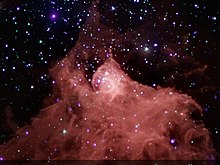Galactic star-forming regions
edit
| Name
|
RA [deg]
|
Dec [deg]
|
l [deg]
|
b [deg]
|
Distance [pc]
|
Age [Myr]
|
Earliest SpTy
|
Number of Stars
|
Cloud Mass [Mo]
|
| 30 Doradus |
84.67665 |
-69.10093 |
279.4652 |
-31.6719 |
49,000 |
|
|
|
|
See also
edit
References
edit
- ^ Lada, C. J.; Lada, E. A. (2003). "Embedded Clusters in Molecular Clouds". Annual Review of Astronomy & Astrophysics. 41: 57–115. arXiv:astro-ph/0301540. Bibcode:2003ARA&A..41...57L. doi:10.1146/annurev.astro.41.011802.094844. S2CID 16752089.
- ^ a b Shuping, R. Y.; et al. (2012). "Spectral Classification of the Brightest Objects in the Galactic Star-forming Region W40". Astronomical Journal. 144 (4): 116. arXiv:1208.4648. Bibcode:2012AJ....144..116S. doi:10.1088/0004-6256/144/4/116. S2CID 119227485.
- ^ Getman, K. V.; et al. (2014). "Age Gradients in the Stellar Populations of Massive Star Forming Regions Based on a New Stellar Chronometer". Astrophysical Journal. 787 (2): 108. arXiv:1403.2741. Bibcode:2014ApJ...787..108G. doi:10.1088/0004-637X/787/2/108. S2CID 118626928.
- ^ Kuhn, M. A.; et al. (2010). "A Chandra Observation of the Obscured Star-forming Complex W40". Astrophysical Journal. 725 (2): 2485–2506. arXiv:1010.5434. Bibcode:2010ApJ...725.2485K. doi:10.1088/0004-637X/725/2/2485. S2CID 119192761.
- ^ Kuhn, M. A.; Getman, K. V.; Feigelson, E. D. (2015). "The Spatial Structure of Young Stellar Clusters. II. Total Young Stellar Populations". Astrophysical Journal. 802 (1): 60. arXiv:1501.05300. Bibcode:2015ApJ...802...60K. doi:10.1088/0004-637X/802/1/60. S2CID 119309858.
- ^ Johnston, K. G.; Shepherd, D. S.; Robitaille, T. P.; Wood, K. (2013). "The standard model of low-mass star formation applied to massive stars: a multi-wavelength picture of AFGL 2591". Astronomy & Astrophysics. 551: A43, 1–23. arXiv:1212.1719. Bibcode:2013A&A...551A..43J. doi:10.1051/0004-6361/201219657. S2CID 54972885.
- ^ Sanna, A.; Reid, M. J.; Carrasco-González, C.; et al. (2012). "Clustered star formation and outflows in AFGL 2591". The Astrophysical Journal. 745 (2): 191–200. arXiv:1111.0843. Bibcode:2012ApJ...745..191S. doi:10.1088/0004-637X/745/2/191. S2CID 118465380.
- ^ Zhang, B.; et al. (2013). "Parallaxes for W49N and G048.60+0.02: Distant Star Forming Regions in the Perseus Spiral Arm". Astrophysical Journal. 775 (1): 79. arXiv:1312.3856. Bibcode:2013ApJ...775...79Z. doi:10.1088/0004-637X/775/1/79. S2CID 119257313.
- ^ Wu, S.-W.; et al. (2014). "The discovery of a very massive star in W49". Astronomy & Astrophysics. 568: L13. arXiv:1407.4804. Bibcode:2014A&A...568L..13W. doi:10.1051/0004-6361/201424154. S2CID 55277847.
- ^ Sample, Ian (7 January 2020). "Astronomers discover huge gaseous wave holding Milky Way's newest stars". The Guardian. ISSN 0261-3077. Retrieved 2020-01-07 – via www.theguardian.com.
External links
edit
